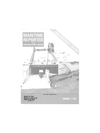
Advanced Vessel To Join Fleet Of Tidewater Marine Joint Venture
One of the most advanced vessels to go into service for Tidewater Marine Service, Inc.'s Australian joint venture company, Tidewater Port Jackson Marine Pty., Ltd. of Sydney, was nearing completion at Carrington Slipways, N e w c a s t l e , New South Wales, when the photo above was taken. The vessel is the Flinders Tide, named in honor of the 18th century explorer Capt. Matthew Flinders, Royal Navy, who discovered and charted large areas of Australia's coastline, with emphasis on the Bass Strait, where the vessel is expected to operate.
"Flinders Tide is designed to provide support for a remotecontrolled vehicle (RCY), which is an undersea submersible used to survey and monitor pipelines and underwater construction, and to aid seabed survey work. The vessel also has important secondary functions that include diving and firefighting roles," according to Ray J. Hope, executive vice president of Tidewater Marine Service, Inc., and J.C. (Bill) Needham, manager of Tidewater Port Jackson Marine Pty. According to Mr. Hope and Mr. Needham, Flinders Tide will be among the most advanced vessels currently engaged in the offshore oil and gas industry and will rank high among the world's most specialized offshore support equipment.
"The RCV, attached to the vessel by cable, will propel itself along the ocean floor, or pipeline, and will relay pictures by television camera to the mother vessel.
It is equipped with remotecontrolled arms capable of handling small objects, wire, shackles, or tools, and is remarkably versatile," they said.
The Flinders Tide will be able to keep station on the RCV by operating in the dynamic positioning mode, maintaining position automatically in winds up to 20 knots with associated seas, plus t w o - k n o t current, either from the same or different directions.
Approximately 51 meters (167 feet) long, the new support vessel will be powered by twin EMD 12 cylinder 645-E6 main engines having a total of 3,000 hp (maximum continuous) at 900 rpm, driving controllable-pitch propellers, and three 600-hp Ulstein transverse thrusters. When in the dynamic positioning mode, the main engines will run at constant speed and control of the main propeller pitch, three transverse thrusters, and twin rudders will be effected by a Honeywell A.S.K.
model 3100 computer. The system will be capable of using either a Decca "Trisponder" surface network or a Honeywell RS 902 hydro- acoustic subsea beacon position reference system.
The RCV will be deployed t h r o u g h a 10-meter-diameter "moon pool," and when engaged in seabed recovery work, will be used in conjunction with deck winches and a hydraulically operated hinged " A " frame stern gantry of 30-ton S.W.L. Two 50-ton, two 10-ton, and two 3-ton hydraulic deck winches will be fitted.
The Flinders Tide has accommodations for divers, and when working in this mode the vessel can be moored in a four-point mooring system p i o n e e r e d by Tidewater Marine. The vessel's anchors will utilize the generalpurpose winches and windlass. In diving support work, a saturated diving system can be provided on deck, and the bell will be deployed through the moon pool which is capable of aeration for this purpose.
Workshops and RCV control room are provided onboard.
A firefighting system capable of delivering 2,400 tons of water per hour will be installed. The two remote-controlled m o n i t o rs will be fitted atop a special gantry crane at the stern. Each will be powered by a 960-hp diesel pump capable of discharging water a distance of 145 meters to a height of 40 meters (475/131 feet).
The Flinders Tide was expected to go into service in January 1981.
Read Advanced Vessel To Join Fleet Of Tidewater Marine Joint Venture in Pdf, Flash or Html5 edition of February 1981 Maritime Reporter
Other stories from February 1981 issue
Content
- Irv H. Dennen Named President Of Fairbanks Morse Engine Division page: 4
- Sale Of IOT To Southern Natural Resources Closed —Executives Announced page: 5
- Two New River Terminals Added By Alter—Third To Be Constructed page: 6
- Dockery Succeeds Warden As President Of Raytheon Marine page: 6
- Omnithruster Awarded INMA Tuna Fleet Contract page: 6
- Gulf Fleet's 102nd Vessel Is Powered By EMD Diesels page: 6
- Newport News Acquires Plant In North Carolina For Sub Support Work page: 6
- Conference Papers On Coal-Fired Ships Available From Polytech page: 6
- Kongsberg Relocates To New Facilities page: 6
- Alvin Goodspeed Named General Sales Manager At GM-Detroit Diesel page: 7
- Bath Iron Works To Build $25-Million Training Simulator For U.S. Navy page: 7
- Port Of Galveston Announces Four Management Promotions page: 7
- Electro-Nav's New Watch Receiver Meets I M C O Requirements page: 7
- Avondale Lays Keel For Largest U.S.-Built Diesel-Powered Containership page: 8
- Cargo Ship For Philippines Owner Delivered By Hitachi page: 8
- Vemar Shipyard Delivers Its First Offshore Rig To Glendell Drilling page: 8
- Report On Domestic Offshore Oil Published page: 8
- Crane Manufacturers Friedrich Kocks And Peiner Have Merged page: 9
- Baxter Named President And Board Member Of The Foxboro Company page: 9
- MARINE DECK MACHINERY A REVIEW page: 10
- Swiftships Delivers GM-Powered Utility Boat To CO-MAR page: 10
- James Thompsen Heads Marketing Of Woolsey Commercial Products page: 10
- Sun Ship To Focus On Ship Repair Work page: 10
- Robert Scott Named Assistant Vice President Of Gibbs & Cox, Inc. page: 10
- SUNY Maritime College Gets $2,000 Grant From Gulf Oil Foundation page: 10
- SAME's Philadelphia Post Elects Officers — Pistilli Named President page: 12
- Waukesha Engine Will Manufacture Sulzer Diesels Under License page: 13
- Halter Delivers Large Pilot Boat For Middle East Service page: 14
- $142-Million Contract For Two Tankers Awarded To Bath Iron Works page: 14
- FMC Coffin Pump Will Produce And Distribute TCU Turbochargers In U.S. page: 14
- New National Officers Elected By Marine Technology Society page: 14
- Blancke Marine Awarded Design Contact For Inter-Island Combo Vessel page: 16
- Shipboard Habitability Conference Sponsored By SNAME April 7-9 page: 16
- Swiftships Takes Over Mangone Shipbuilding From Stewart And Stevenson page: 16
- Petersen And O'Hara Elected Vice Presidents For Todd's L.A. Division page: 17
- Stanwick Corporation Appointed Exclusive Agents For Fredriksstad page: 17
- Hitachi Zosen Gets Orders For Two More Semisubmersible Rigs page: 18
- Bethlehem Boston Yard 1980 Workload Of 80 Ships Equaled 1979 page: 18
- NASSCO Launches Products Carrier For Union Oil Company page: 18
- New Satellite Navigator Receiver Announced By Racal-Decca Navigator page: 18
- T.J. Lamb Named Systems Department Sales Manager At Engelhard Industries page: 18
- Navy Honors Sperry Contribution On 25th Anniversary Of FBM Program page: 19
- Jumboized 'Seawise Giant7 Is Now World's Biggest Tanker page: 19
- Haig And Hayward Honored At Navy League Annual Dinner page: 20
- Bethlehem's Beaumont Yard Had Outstanding 1980—Booked Into '82 page: 20
- China Shipbuilding Will Build Third Jackup For Santa Fe International page: 22
- Thomas Moran Named Chairman Of The Board For Moran Towing Corp. page: 22
- B&W Yard To Continue Technical Assistance To Samsung Shipbuilding page: 24
- Robert McCarthy Joins DEBEG Marine As Sales Manager page: 24
- Halter Marine Delivered 64 Commercial Vessels In 1980 page: 25
- Donald Chrisco Named Director Of Materials At St. Louis Ship page: 26
- Giant Belcher Barge Launched In Galveston page: 26
- NASSCO To Retrofit Three Tankers At Total Cost Of $19.8 Million page: 26
- Zigler Yard Launches 80,000-Barrel Tank Barge For Louisiana Marine page: 26
- Advanced Vessel To Join Fleet Of Tidewater Marine Joint Venture page: 27
- Zidell Awarded Big Repair Job On Army Dredge 'Pacific' page: 27
- Jackup Rig For Foramer Completed By Hitachi page: 28
- Wall Shipyard Completed $11.5 Million In Vessel Repair Work And Service In 1980 page: 28
- ASNE Flagship Section Hears Report On Craft's Aerodynamic Enhancement page: 29
- Dock Express Transports Offshore Modules To Bahrain page: 29
- Bond And Houston Get New Posts In Texaco's Marine Sales Department page: 29
- Caterpillar-Powered Trawler Completed By G&W Industries page: 32
- Cadiz Yard Of AESA Delivers Three Containership Conversions page: 32
- Saint John Yard Selects Sperry, And Gibbs & Cox For Frigate Design Team page: 32
- NICOR Inc. Acquires Acadian Marine Service page: 33
- Subsidy Board Approves CDS For $1.7-Million Delta Line Retrofits page: 33
- Guralnick Associates Awarded Study Contract By State Of Alaska page: 33
- Two Big Bulkfleet Barges Christened At Quincy Yard page: 34
- Dravo SteelShip Delivers Three Towboats To Radcliff page: 34
- Wesmar's Scanning Sonar Has Long Range For Greater Efficiency page: 34
- C.G. Caras Rejoins Ogden Corporation As Vice President page: 34
- GE Reorganizes Its Installation & Service Engineering Division page: 36
- Gulf Oil Opens New Service Facility In Staten Island, N.Y. page: 36
- Students Present Papers At Meeting Of SNAME New England Section page: 36
- Brochure Describing New Diesel Lube Oil Available From Mobil page: 36
- Captain McVay Named Vice President Of Moran Towing & Transportation page: 37
- Mynaugh Appointed Engineering Manager At Interocean Management page: 37
- Robert Nystrom Named Division Chief At Anderson Associates page: 37
- Todd Gets $32 Million In Commercial Contracts- Earnings Up For Quarter page: 37
- Allis-Chalmers Named U.S. Licensee For B&W Slow-Speed Diesels page: 39
- Newport News Completes Jumboizing Of Two Tankers page: 40
- Marine Industries Hosts Reception For NYC Shipowners page: 40
- Gulf Fleet To Provide Five Vessels For India's Offshore Operations page: 40
- NKK Delivers Its First Car/Bulk Carrier With Hoistable Decks page: 41
- Naval Civilian Administrators Establish New Chapter page: 41
- IOT Announces Two Management Appointments page: 41
- Burmeister & Wain Delivers First Panamax Bulk Carrier page: 42
- Floating Weir Skimmer Collects Oil Spills In Harbors Or Offshore page: 42
- Todd-Seattle Yard Promotes Five—McDonnell Appointed Assistant General Manager page: 43
- Future Ship Designs Topic At ASNE Northern New England Section Meeting page: 43
- Hitachi Completes Jackup Drilling Rig For India page: 43
- $2.5-Million Order For SPM Inventory Buoy Awarded To IMODCO page: 43
- Executive Appointments Announced By Crowley Caribbean Division page: 43
- VHF Automatic Digital Direction Finders Announced By Simrad page: 43
- Blount Marine Delivers Deutz-Powered Cruise Vessel page: 43
- Chesapeake SNAME Discusses World Shipbuilding Practices page: 44
- Roland Malins-Smith Joins Concorde Line As Vice President page: 45
- New Brochure Describes Repair Facilities At Norfolk Shipbuilding page: 45
- F.A. Martin & Ottaway Expands Operation To United Kingdom page: 45
- Benson Named Manager Of Peterson's Hazardous Materials Division page: 58
- Derrick/Supply Vessel Now In Gulf Service For Tidewater page: 58
- Two Detroit-Powered Tugboats Completed By Manly Shipyards page: 58


